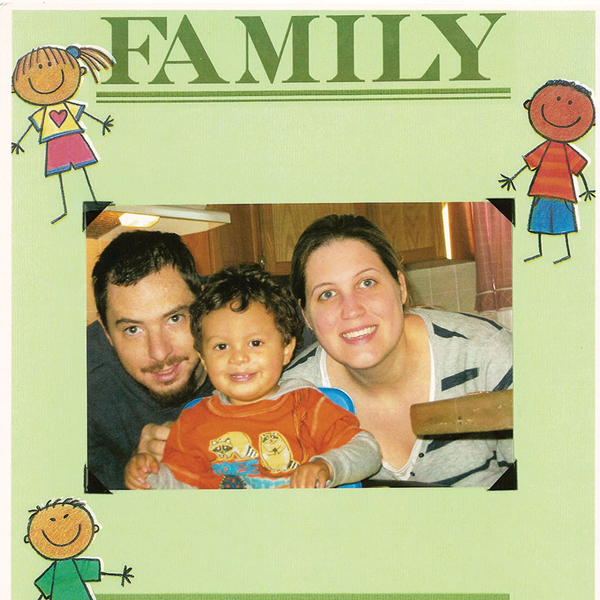When my husband and I decided to adopt, we filled our bookshelves with every adoption-related story we could find. But once our daughters came home, we realized that the most intriguing adoption tales we’d heard were our own children’s histories.
As we thought about it, we realized that putting our daughters’ stories on paper made sense. Our agency’s waiting-parent training stressed the importance of sharing your child’s adoption story with her from a very young age — and what better way to share that story than as a homemade bedtime book? The books would allow us to plot out a perfect “script” to start our conversations, a leaping-off point that will serve as “the story” when the kids are toddlers, and the beginning of a deeper discussion as the girls get older.
These books wouldn’t be the storehouses of all those precious mementos we’d gathered during our adoption journey — I wasn’t about to pull out any scrapbooking tools. I wanted to craft simple, sturdy books that could be put in the girls’ book baskets, books that small hands could handle whenever the mood struck.
So I set to work creating their stories. I had no trouble finding the perfect pictures among the hundreds we took on our adoption trips, and the precious few we had of their early lives. But finding the words to tell our daughters’ stories — well, that was more challenging.
I wanted to make the stories accurate, but still leave out a few details until my daughters were old enough to understand concepts like abandonment. I wanted to include something about their origins, but not to provoke a birds-and-bees conversation with two toddlers. And most of all, I wanted to make the stories entertaining, so the girls would want to hear them over and over again.
But even though I make my living writing stories, I had trouble finding the right words — and the right ways — to put my daughters’ histories on paper. If you’re daunted by the same task, here are a few ideas to help you get started.
Remember, a Picture is Worth a Thousand Words.
There’s a reason children’s books feature photographs or illustrations — pictures engage children’s imaginations and help them to understand the story. For an adoption story book designed for a very young child, less is definitely more. “One or two photos from each place or person is enough,” says Justice Riccardi, who adopted her son domestically.
If you are short on images, get creative. Draw your own illustrations, or find another way to represent that part of the story. You may not have a photo of your child with his birth mother, but do you have any shots of him with his foster mom?
Keep the Focus on your Child.
“Kids don’t really care about the paperwork or other things that adults think about — they want to know what they were like when they were little,” says Karen Katz, author of dozens of children’s books and mom to a daughter adopted from Guatemala. “They want to know that you thought they were the cutest baby in the whole world, that you loved them and kissed them so much, that they’re growing up to be big and strong.”
Katz’s adoption story book, a collection of photos and handwritten text in a picture album, is still pulled out from time to time by her 18-year-old daughter. It was the inspiration for her first book, the adoption fairytale Over the Moon — and it led the former graphic designer into a new career as a children’s author.
Stick to the Major Events.
While it is tempting to include every detail, experts and parents all agree that simpler is better. “You don’t want to overwhelm a very young child with too much stuff,” says Eve Wierzbicki, owner of My Creations Books, which creates customized adoption story books. “You always want to be honest, but you don’t want to get into too much detail too soon. When your child is older, you can share more as you read the book.”
Make it Action-Packed.
While there’s room in a story book for a few posed photos (many parents choose to conclude their books with a family portrait), be sure to balance those with photos of your child or Mom and Dad doing something. “Put in something your child can connect with and stories that he can retell, to create a web of memories,” says JoAnne Solchany, Ph.D., a child therapist and adoptive mother. “Instead of a portrait, include pictures of his first sleigh ride, or of Uncle Jack carrying him on his shoulders.”
Katz recommends choosing photos that show everyday life with your child. “We wanted our daughter to get a sense of the day-to-day experience of being in Guatemala, and the first days we spent with her — ‘we took you to the doctor; Mommy gave you a bath; we played silly games; we were so happy to be together.’”
Acknowledge the Birth Family.
Even if you have little or no information about your child’s birth parents, you should include at least a sentence or two about them. “Adopted children need to know that, like other children, they were born to real people,” says Joni Mantell, LCSW, CSW, director of the Infertility and Adoption Counseling Center. “Otherwise, they may develop fantasies about their origins being different from those of other children.”
Without an acknowledgement of the birth family, some children might imagine that they magically appeared on the planet, or arrived on a plane — and may think that the topic is taboo. “Just one sentence is enough to send the message to your child that it is OK to talk about birth parents,” Mantell says. If you’re worried that introducing the idea of another mommy and daddy at this age might confuse your child, find other words to identify the birth parent(s). Mantell suggests “the woman who carried you before you were born” or “the tummy lady” as alternatives.
Most parents who adopt domestically include multiple pictures of the birth family — and some create whole books about their children’s birth families. “I felt it was important for my daughter to know that her birth mother wanted what was best for her, and that all parties involved in the adoption love her,” says Alexis Itoh. She wrote, “Your birth mother worked very hard to find just the right family for you. She wanted you to grow up in a home where you had opportunities she couldn’t provide. Your birth mother looked at hundreds of families who were hoping to share their love with a child — that’s how she found us.”
In international adoption, where families often receive few, if any, details about the birth parents, it’s easy to fall into this trap. “Sometimes parents who adopted internationally prefer to talk about their child’s heritage, but a child is born to birth parents, not to a country,” Mantell says.
Accentuate the Positive.
A child who’s still scared of monsters in the closet isn’t ready to face painful information about her past — in a toddler book, it’s OK to stick with the safe and cozy. “I didn’t put any of the more difficult parts of my daughters’ adoption stories in their books,” says Julia Schulman, mom to two daughters adopted from China. “These are feel-good books that are supposed to make their little hearts swell — just the happy parts.”
If your child came from a background of poverty, abuse, or neglect, you may need to stretch to find the positive. “Find something nice to include — you get your dark, curly hair and your athletic ability from your birth dad, from your birth mom you get your eyes,” says Paula Schuck, an adoptive mom in London, Ontario. “You certainly aren’t going to write that your birth mother left you alone, and your birth father had a criminal record.”
But be careful that, when you’re stretching to find that positive, you don’t create a fiction for your child. “You shouldn’t include anything in this story that contradicts anything you will reveal later,” Mantell warns. A white lie told now may cause your child to lose faith in you when he discovers the truth later.
Keep Explanations Kid-Friendly.
Preschoolers are concrete thinkers, so keep the information you want to share simple and literal. “Whenever you can, use childlike explanations,” says Mantell. “Poor can be explained as ‘not able to buy the things that babies need,’ accompanied by pictures of bottles, cribs, and so on.”
“One of the biggest challenges was finding the right words to explain why my son’s birth mom can’t take care of him,” says Riccardi. “I wrote that she had ‘big grown-up problems that made it hard for her to care for you or any other baby.’ I also repeated the phrase ‘babies need food, clothing, toys, and a home,’ and added that his birth mother could not provide those things.”
Make it Interactive.
Kids love to participate in stories, so find ways to engage your children in their books. You could make the book a “touch and feel” by including swatches of fabric from the outfit your child was wearing when you met, or the blanket you carried her home in. Or simply pose questions within the text. “We make our books exciting by including questions, like, ‘and guess what?’” says Wierzbicki. “If a child has read the story before, he can jump in and give the answer.”
You’ll likely design this book to have a sentence or two on each page — but as your child advances developmentally, you can ad-lib more details as you read. Now that our oldest is nearly five, we share some of our rich memories of the day we met (she screamed bloody murder, then held out a sweet rice cracker for me to take a bite of), in addition to the bare-bones text.
Build it Kid-Tough.
Save the intricate scrapbooking for a separate book. This story needs to be available to your child whenever he wants to look at it, so make a book that will stand up to rough handling. “Don’t use fancy paper — we use laminated pages, so children can look through it as often as they want to,” Wierzbicki says.
Consider making a book that can change as your child grows — something that you can expand with more pages or change the text to as you see fit. “We used a three-ring binder, and placed the pages in protective plastic sheets. We also made copies, in case our son spills on it,” Riccardi says.
Don’t Stress Over It.
Many of us are daunted by the thought of putting our children’s histories on paper, but, when it comes down to it, you simply need to tell the story truthfully and with love. “Don’t worry about getting it perfect, and don’t worry about making it look professional,” says Schulman. “Make it totally personal to your family and to your taste.”
Mom Donna Sweeney echoes this sentiment. “Have fun when you’re creating the book — if you feel silly, be silly. Your child’s story book must be a true representation of who you, your child, and your child’s birth parents really are.”
Katz says there’s no wrong way to create this book. It’s only wrong to decide not to do it. “Work from your feelings of love and how you want to express it,” she says. “Every parent will find her own way of putting her heart in the book.”
Examples to Inspire Your Adoption Story Book

After writing an outline, it took DEBBIE
BROWN just three hours to create her
daughter’s book at creativememories.com.
She printed a second copy to send to
the birth mother.

As an artist, it was natural for JULIA
SCHULMAN to craft a personal story book
for each of her daughters. She copied
and bound her original watercolor-
illustrated pages at a copy shop.

MY CREATIONS, at mycreationsbooks.com,
allows users to fill in names and other
details of an international or domestic
(shown) storyline, choose characters’ skin
and hair colors, and order a laminated book.

JUSTICE RICCARDI designed eye-
catching pages using photos and stickers
on bright backgrounds. Before slipping
the pages into plastic protectors in
a binder, she made a color copy of
the complete book.

Former teacher DONNA SWEENEY
decided to use a blank, bound book,
sold at teacher-supply stores.
She pasted typewritten text on
the left-hand pages, and a family
friend illustrated the story



